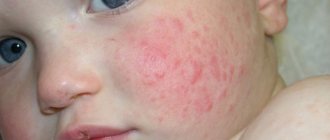Children are naturally active because they have a lot of energy to expend.
Therefore, they jump and run, “climb heights,” rollerblade or roller coaster, and so on. Of course, such “somersaults” have a vocal accompaniment: scream, squeal, roaring laughter, or cry if you “suffer losses” (broken knees, elbows, and so on).
However, during active games, your child may “swallow” cold air, become hypothermic, or sweat. And the formidable virus often “flies” nearby, so the baby can easily “catch” it.
As a result, the baby gets sick, which is often manifested by hoarseness of the voice or its disappearance, and sometimes shortness of breath develops (it becomes difficult to breathe). This condition is called acute laryngotracheitis, which is a manifestation of several diseases. What's happening? Let's figure it out.
Mysterious laryngotracheitis - what kind of “beast”?
Acute laryngotracheitis is an inflammatory disease of the larynx and trachea, which leads to swelling of their mucous membrane and impaired vibration of the vocal cords. Therefore, the lumen of the larynx narrows, preventing the passage of air to the lungs, and the voice also changes. Moreover, there is a risk of developing an attack of suffocation.
Children under 7 years of age are most prone to laryngotracheitis.
A little anatomy...
The larynx and trachea are hollow tubes, and the laryngeal cavity contains two types of vocal cords:
- True ligaments are muscles and bundles of elastic fibers that have a special structure. They are affected by diphtheria (true croup), a dangerous infectious disease that previously had a severe course, leading to death due to asphyxia (suffocation). However, due to routine vaccination, the disease is now rare.
- False cords are folds of the mucous membrane of the larynx (located below the true vocal cords) that protrude into its cavity. When they are affected, laryngitis (false croup) develops, and if the disease is accompanied by inflammation of the tracheal mucosa, laryngotracheitis. Moreover, the symptoms of both diseases are similar, so we will consider them together further.
Causes of acute laryngotracheitis in children
This disease can threaten the life of a child, since another name for this nosology is acute stenosing laryngotracheitis or false croup.
Acute laryngotracheitis in children occurs as a result of the penetration of an infectious agent into the mucous membranes of the respiratory tract, and most often these are viral agents and features of the anatomy of the respiratory organs of childhood (a large amount of loose fiber in the subglottic space, good pliability of the cartilage of the larynx and trachea, a rich network of blood vessels).
The main mechanism for the development of the disease is the inflammatory process, which is accompanied by edema, infiltration of the subglottic space, hypersecretion of the glands of the mucous membranes, as well as narrowing of the airways.
Acute stenotic laryngotracheitis develops in children, which can impede the passage of air and contribute to the development of airway stenosis.
Why are children at risk?
In children of the first years of life, the structure of the larynx has some features:
- The narrow lumen is due to the fact that in babies the true vocal cords are somewhat shorter than in older children. In this case, the false vocal cords protrude more into the laryngeal cavity.
- The mucous membrane is prone to swelling because it is rich in blood vessels, from which, during inflammation, the liquid part of the blood leaks into the surrounding tissues.
- Under the mucous membrane of the larynx there is loose fiber, which, due to its structure, retains water. However, by about age five (sometimes later), it gradually disappears.
All these points together, when exposed to certain factors, quickly lead to inflammation and swelling of the mucous membrane, narrowing the lumen of the larynx.
Which children are at increased risk of developing laryngotracheitis?
- If they were born prematurely or with low weight, suffered a birth injury or oxygen deprivation (in utero or during childbirth). In these cases, the compensatory capabilities of the body are disrupted.
- They are prone to allergic reactions (urticaria, Quincke's edema, allergic rash), have allergic diseases (for example, atopic dermatitis) or exudative diathesis (most often exudative-catarrhal).
This also includes children who were transferred early or were bottle-fed from birth. What's happening? Cow's milk protein enters the body, which makes it allergenic. Therefore, the immune system malfunctions.
Causes and mechanism of development: bringing the “culprits” to “clean water”
Various factors can lead to the occurrence of acute laryngotracheitis, but two main groups occur most often in children.
Infectious and inflammatory diseases
- Viral infections are the most common cause: influenza virus (especially dangerous) or measles, parainfluenza, adenoviral infection.
- Bacterial infections : Staphylococcus aureus, streptococcus (the most common causative agent of chronic or acute tonsillitis) and others.
What's happening?
“Favorite” seasons are autumn-winter or winter-spring.
Slush and damp weather is especially dangerous. Because hypothermia occurs very quickly, and viruses survive more easily in the environment. As a result, the immune system experiences stress and has difficulty performing its main function - protective.
Therefore, the baby becomes vulnerable to viruses that easily enter his body from other sick children on the playground or in kindergarten.
In addition, during hypothermia, bacteria “wake up” in foci of chronic infection, which were “sleeping”, waiting for the right moment. The most common culprits are chronic respiratory diseases: tonsillitis, bronchitis, sinusitis.
Development mechanism
Once on the mucous membrane of the larynx and trachea, pathogenic microorganisms cause inflammation in it. Therefore, it swells, involving the vocal cords in the process. As a result, their oscillation and closure are disrupted, and the lumen of the larynx narrows, preventing air from entering the lungs.
Allergic reactions or diseases
They cause the development of allergic laryngotracheitis or laryngitis, and also aggravate the course of bacterial or viral infections. Moreover, the disease can occur either independently or in combination with a narrowing of the lumen of the bronchi (obstruction).
What's happening?
Most often, allergic laryngotracheitis develops when inhaled allergens (with air), pollen, odors, and others enter the upper respiratory tract. However, any allergens (for example, food) can also lead to the development of the disease.
Development mechanism
In acute cases, an immediate allergic reaction occurs. That is, symptoms develop quite quickly.
The allergen acts on the target organ (in this case, the larynx and trachea), releasing special substances from mast cells (cells of the immune system located in tissues) that cause local immune inflammation. The greatest role is played by histamine, which leads to contraction of the muscles of the larynx, as well as increased vascular permeability for the liquid part of the blood, which enters the loose tissue, causing the development of edema. As a result, the lumen of the larynx narrows.
Treatment of laryngotracheitis
Treatment, as a rule, is carried out on an outpatient basis and, if properly organized, leads to complete recovery within 5 to 10 days.
Doctors usually prescribe antihistamines to relieve swelling. Coughing attacks are relieved by taking bronchodilators, which are available for children in the form of pleasant-tasting syrups.
The otolaryngologist will definitely prescribe physical procedures - laryngeal inhalations.
For a speedy cure, strict adherence to the appropriate regimen for the patient is required:
- The room should have fresh, humidified warm air. Daily wet cleaning is required to prevent dust accumulation.
- The sick person is forbidden to talk, so as not to strain the vocal cords. If necessary, only in a quiet whisper.
- There should always be plenty of warm fluids.
- Spicy, salty, sour foods, too cold or hot foods are excluded from the diet.
- Regular gargling with pharmaceutical preparations or herbal infusions (chamomile, sage) is carried out.
- Take hot foot baths every day before bed.
- Smokers will have to give up this habit. Alcohol consumption is strictly prohibited.
Signs of acute laryngotracheitis: you need to know the “enemy” by sight
In an infectious-inflammatory process, manifestations of false croup occur against the background of symptoms of the underlying infection: fever, cough, runny nose, pain, sore throat. Moreover, laryngotracheitis with a viral infection develops either in the first two days of the disease, or on days 3-5, when a bacterial infection occurs.
If false croup is caused by an allergen, it can develop against the background of the child’s general well-being.
Laryngotracheitis is manifested by a triad of main symptoms:
- Hoarseness of voice until it disappears (in severe condition)
- A "barking" cough ( often described as "seal barking" or "crow cawing") is a hallmark of laryngotracheitis
- Shortness of breath ( difficulty for the child to take a breath)
The severity of each of the signs depends on the degree of narrowing of the lumen of the larynx:
First degree (compensated). A dry cough appears, which quickly gives way to a “barking” cough. There is moderate hoarseness and hoarseness of the voice, which increases with crying. Also, during exertion (for example, during a game), noisy and moderately rapid breathing appears, which is characterized by difficulty breathing (inspiratory dyspnea). Whereas at rest the baby breathes calmly.
Second stage (partial compensation). The child is scared and restless. Breathing becomes noisy and audible at a distance (has a “sawing” character). Shortness of breath intensifies, and during breathing the wings of the nose moderately inflate, and the skin above the sternum and between the ribs is slightly retracted. The skin around the lips and fingertips turns blue - signs of lack of oxygen.
There is pronounced hoarseness of the voice even at rest. Periodically, a “barking” cough may change to an intrusive and rough one. Moreover, the signs can be either constant or appear intermittently.
Third stage (uncompensated). The child's anxiety and intimidation are replaced by periods of lethargy. Shortness of breath is constant and severe: the skin above and below the sternum is sharply retracted, as well as between the ribs. At the same time, the skin becomes covered with cold sweat and becomes pale.
At rest there is pronounced hoarseness of voice. At first, the cough is rough and loud, then, as the lumen of the larynx narrows, it becomes somewhat quieter.
Fourth stage. The child loses consciousness, and breathing becomes shallow, frequent and irregular.
Moreover, in practice there is often no clear line between the degrees. In addition, if the general condition worsens over several hours, the larynx can quickly narrow, leading to the development of a life-threatening condition: an attack of suffocation.
Therefore, there are indications for calling an ambulance without waiting for the child’s well-being to worsen:
- Severe hoarseness of voice at rest
- Blue skin around lips and fingertips
- Moderate flaring of the wings of the nose, as well as retraction of the skin between the ribs and above the sternum
- The appearance of shortness of breath and noisy breathing at rest
- Baby is scared and restless
- A “barking” cough periodically changes to a rough and intrusive cough
However, in order to prevent the development of an attack of suffocation, it is better to consult a doctor at the first symptoms of laryngotracheitis.
Symptoms
Symptoms of laryngotracheitis usually appear against the background of a viral cold and are accompanied by a runny nose, sore throat, fever, and pain when swallowing.
Acute laryngotracheitis is accompanied by severe pain in the throat and difficulty when trying to take a sip of liquid. The patient loses his appetite, he experiences increased symptoms of intoxication, and his overall condition worsens significantly.
A serious danger with laryngotracheitis is laryngeal stenosis. With this phenomenon, the access of air to the lungs is completely or largely stopped as a result of severe narrowing of the larynx.
Characteristic symptoms of laryngotracheitis are voice changes. It becomes hoarse, rough, and loses sonority. Laryngotracheitis is accompanied by a dry, barking cough, more often in the morning and at night. After a coughing attack, the patient feels pain in the chest. A cough can be triggered by taking a deep breath, laughing, or inhaling cold, polluted air.
At first, the cough is dry, without phlegm. As the disease progresses, the cough is softened by the appearance of sputum. Over time, the sputum becomes mucopurulent and profuse. At the same time, pain, sore throat, and constant discomfort when swallowing are noted.
The acute form of the disease without adequate treatment turns into chronic laryngotracheitis. The disease is characterized by a long course with frequent exacerbations.
With chronic laryngotracheitis, the patient complains of a constant dry cough. Hoarseness of voice is noted, especially in the morning and evening. It is difficult for the patient to talk for a long time, the voice becomes hoarse.
What will the doctor do?
At home, you can cope with the disease, but if the symptoms of the disease are not pronounced (the first and the beginning of the second stages of laryngotracheitis). However, only if the baby receives treatment prescribed by the doctor :
- Antiviral drugs or antibiotics to fight the pathogen.
- Antiallergic drugs because they block the production of immune inflammatory mediators by mast cells. As a result, swelling of the mucous membrane decreases and the muscles of the larynx relax.
- Inhalation using a nebulizer (ultrasonic, compressor or electronic mesh). Moreover, you should use solutions recommended by the doctor.
- Multivitamins to improve the functioning of the immune system.
- Other medications that the doctor prescribes depending on the general condition of the child and the presence of other symptoms of the disease.
Whereas when an attack of suffocation develops, hormonal drugs (glucocorticoids) are used. The frequency and method of administration (IV or IM) depend on the severity of the child’s condition.
Are there signs of suffocation? Don't panic: we keep the situation under control!
Most often, the child’s condition worsens at night, but an attack can also develop during the day.
If alarming symptoms (described above) appear, call an ambulance immediately, and before it arrives, alleviate the baby’s condition.
What to do?
Calm down, because seeing your confusion, the baby will get excited and cry - then it will be more difficult for him to breathe.
Act quickly to help your baby, but without being too fussy.
Provide air access to the room: open the windows or a window, after wrapping the baby or dressing him warmly if it is cold outside.
Place your child in a position that allows air to flow more freely into the lungs:
- If the child is small, hold him in your arms so that he is in an upright position
- Give your older baby a semi-sitting position in bed.
Try to reduce swelling of the laryngeal mucosa:
- Carry out inhalation using a nebulizer using saline solution or mineral water.
- If you don't have an inhaler, take your child into a steamy bathroom.
However, if the baby has an elevated body temperature, then these manipulations are not recommended.
Taboo with laryngotracheitis
Do not begin to treat the child yourself, as your actions may worsen the narrowing of the lumen of the larynx.
What not to do?
- Use oil inhalations , as they increase swelling of the laryngeal mucosa.
- Place mustard plasters on the chest; they increase blood flow to the chest and vascular permeability.
- Carry out hot steam inhalations (kettle with hot water, breathing over boiled potatoes) if the child is too small. Because it can cause a burn to the mucous membrane of the mouth and pharynx.
In addition, exclude food allergens (honey, raspberry jam, etc.) from the diet if the child is prone to allergic reactions.
Diagnosis of acute laryngotracheitis
The main stages of diagnosis are the clinical picture of the disease and the presence of a predisposing disease that could intensify the inflammatory process, for example ARVI: influenza, adenoviral infection, parainfluenza, etc.
History data and complaints of cough, shortness of breath, fever and worsening general condition at night.
Other diagnostic methods may be: x-ray examination of the lungs to exclude other pathologies, examination of the oral cavity and pharynx in mirrors, examination of smears for the presence of inflammatory agents.











